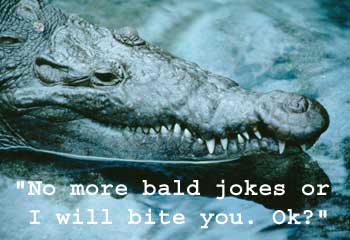|
Over 50% of men are bald or have significantly
thinning hair by age 50. Whilst 20% of women are thinning and 5%
are losing their hair in clumps around the crown by the same age.
Baldness is a big deal. Acclaimed journalist Christopher Wanjeck
guides us in a brief history of baldness cures.
by Christopher Wanjek
A quick scan on the
Internet will reveal hundreds of products claiming to cure baldness.
One of my favourites comes from an Ayurveda guru in India who recommends
headstands to increase blood flow to the scalp, coupled with a herb
called bhringaraj, which is supposed to counter some type of unbalance
in one of the three Indian life forces. It is my favourite cure,
I should add, because the guru is bald.
The history of baldness cures
can be summed up rather succinctly. From prehistory to the late
1980s, nothing worked. All baldness cures were figuratively and
often literally snake oil. Then came Minoxidil (marketed as Rogaine)
followed quickly by Finasteride (marketed as Propecia or Proscar).
These products don't grow new hair, but they prevent hair loss.
Mind you, I am not a Minoxidil
salesman. I don't even view baldness as a disease that needs to
be "cured." Never will you hear: "Shame about Bob.
The doctors said it was the baldness that killed him. If only he
kept his baldness under control." What is fascinating to me,
however, is that in this age of enlightenment many continue to be
lured by so-called natural ointments, massage techniques and even
sillier baldness remedies all based on ageless superstitions and
misconceptions about the root cause of baldness.
Blame It On
Yahweh...
Baldness has always
had a bad rap. Countless references in the Bible note that God will
make Israel's enemies either bald and sterile, bald and confused,
bald and feeble, or just plain bald. In Revelations, at the end
of the world, God will render select groups of evil people bald.
You know about Samson, whose
great strength was in his hair. The (bald) prophet Elisha no doubt
took that story too personally, as relayed in the Second Book of
Kings. On the road out of Jericho, a group of boys made fun of Elisha,
shouting "Get out of here, baldy." Elisha cursed them
so that "two she-bears came out of the woods and tore forty-two
of the boys to pieces." His ways are mysterious.
The ancient Egyptians were among
the first to develop treatments for baldness - rancid fat from snakes,
geese, crocodiles, hippos, lions, and ibexes. These were serious
topical ointments; no greasy kids' stuff. The bad smell was key,
for it was proof that the concoctions were working. We're still
fooled by this concept today, for everyone knows medicine is supposed
to taste bad. Denorex, a dandruff shampoo, prided itself with the
motto "it tingles."
The great Greek doctor Hippocrates
treated his patients' baldness with pigeon droppings. Aristotle,
as brilliant as he was, tried goats urine to remedy his own baldness.
Julius Caesar was bald, which is ironic because the name Caesar,
from the Latin "caesaries," means "abundant hair."
His gal Cleopatra prepared pastes for him made of ground horse teeth
and deer marrow. (Rancid hippo fat was apparently passe in the Egyptian
courts by this time.)
Alas, Cleopatra's salves didn't
work. Neither did Roman cures of sulfur, tar, and the finest samples
of animal urine from around the Mediterranean. Julius caved in and
simply tried to cover his bare head; he took to wearing wreaths
of laurel. (He was known as the king of bad comb-overs, too, according
to Roman scribe Pliny.) The mighty Hannibal was bald and didn't
like it one bit. Like Captain Kirk in Star Trek, Hannibal was never
in a fight scene without his toupee.

Based on an Everglades National Park Photo
A Crocodile
reaches the end of his tether after teasing from fellow
river dwellers about being a possible cure for baldness.
|
Baldness treatments such as
urine and rancid fat survived the fall of the Roman Empire, unlike
those worthless, pagan tomes on geometry and iambic pentameter.
The Renaissance brought cow saliva. (Ah, cow saliva, not cow urine.
Progress.) Meanwhile in China, treatments moved forward with the
introduction of animal testes mixed with ground herbs. Meditation
and headstands had long been a standard cure there and in India.
With the advent of modern technology
in the late 1800s, baldness treatment entered the realm of the titillating:
electric shock, vibrators, motorized scalp massagers, and suction
devices.
Nice Try, But
It's Wrong...
What do all these treatments
have in common, aside from the potential of making you look foolish?
They all work on three premises: increasing blood flow to the scalp,
unclogging pores or hair follicles, and providing nutrients. Maybe
these treatments really do that. These aren't the causes of baldness,
though.
Baldness, for the most part,
is genetic. You'd have to be literally starving to lose your hair
due to poor nutrition. This is certainly possible, but far from
likely. You don't need extra blood up there either. The head is
already flush with blood. The brain kind of needs blood, and the
body makes sure to deliver it through two massive arteries in your
neck called the carotids.
The clogged pore idea is straight-out
wrong, unless you're coating your scalp with sealing wax... or rancid
hippo fat. You can lose your hair from stress, medication, or chemotherapy,
but usually the hair grows back.
Genes are behind most of the
bald and thinning heads out there, male and female. You can inherit
baldness from your mother or your father. Baldness is not passed
only through the mother's side. A quick look at the countless number
of bald fathers and sons will nullify this myth.
How Hair Works...

How an astronaut
could potentially look if they donned a purple wig
|
The head has about
100,000 hair follicles, little hair factories that continuously
produce hair under normal conditions. When a hair falls out, a new
one grows in that same follicle. Hair loss begins when a certain
enzyme converts the hormone testosterone into another hormone called
dihydrotestosterone (DHT).
DHT is critical in the male
fetus development. The hormone also stimulates long, usually unwelcome
rigid hair on the chin and cheeks, different from a beard. Later
in life, for reasons unknown, DHT starts bugging the hair follicles
on the top of the scalp. These follicles continue to produce hair,
but it is very fine and short, a peach fuzz.
The hair follicles on the side
of the head, also for reasons unknown, are not affected by DHT.
They continue to produce thick hair, hence the "monk ring"
of hair that is left when other hair falls out. The bald gene (actually,
there may be many, researchers think) makes too much of the enzyme
that makes DHT.
Minoxidil was introduced as
Rogaine in 1988. This topical solution maintains thinning hair from
falling out through, believe it or not, some unknown process. Minoxidil
was first a blood pressure medication; hair growth in unwanted places
was a side effect.
Finasteride entered the arena
in the 1990s, marketed as a pill called Propecia or, in higher doses,
Proscar. Taken orally, these pills maintain hair that would have
been lost by inhibiting that enzyme responsible for balding. These
drugs have to be taken continuously, or hair loss returns.
That's the state of hair loss
and growth today. Rancid hippo fat and goat urine are not popular
remedies anymore, but equally foolish and exotic Chinese and Far
East herbal remedies are readily available for purchase through
the Internet.
Many products claim to be secret
formulas. I get a kick out of the implied conspiracy. "Dermatologists
don't want you to know!" Yes they do. Doctors aren't interested
in holding back baldness cures; they'd make more money selling cures
that work. There's no worldwide plot to keep you, your husband,
or your brother bald.
Closer to home, health-food
stores market vitamin and minerals to promote hair growth. These
are all worthless too. Rapid, unexpected hair loss is certainly
a sign of deteriorating health. By all means, see a doctor if this
is happening to you. But if you are bald or thinning, your hair
loss is almost certainly not a result of your diet, your circulation,
your clogged pores, your poor chi, your reliance on commercial shampoos,
your yin, your yang, your repulsion of goat urine, or your fondness
for McDonald's hamburgers. Rather, someone in your family - maybe
a generation or two ago - was bald.
There is hope. Usually, hair
follicles never "die" until very late in human life. Bald
individuals have very tiny hairs in most of those 100,000 follicles.
If the right drug comes along, those same hair follicles can start
producing longer, thicker hair.
Hair transplants take hair,
root at all, from the back and side of the scalp and move it up
top. This works, no myth here, but the procedure can be painful
and expensive. Having a skilled doctor is key to its success.
I say the word "hope"
because baldness is a great concern to many people. Ladies, don't
you snicker about the guys. This is no vain pursuit. Twenty percent
of women have thinning hair and 5 percent loose it in clumps around
the crown, just like men. And it's a real big deal for them, too.
Very soon, perhaps
within a decade, scientists predict, there will be a drug that spurs
head hair growth. At first it will likely have some ridiculous side
effect, like impotency or hypertension. Then, after a few more years,
the kinks in the drug will be worked out. Researchers know what
causes hair to stop growing; and pharmaceutical companies are pouring
millions of dollars into drug development because they know the
anti-baldness pill will be as big as Viagra.
Now,
Click
Here for our Special Hair Fact File! for Twenty Great Hair Facts
| Christopher
takes great pleasure in de-bunking and de-mystifying medical
'wisdom' on such topics as vitamin O, magnets and oxygen in
his new book 'Bad Medicine' published by Wiley.
Christopher Wanjek, MPH
(Masters in Public Health, from Harvard) is a U.S.-based science
journalist and author of the book "Bad Medicine: Misconceptions
and Misuses Revealed" (Wiley, 2003). Of which Baldness
is just one of over forty fun topics discussed!
|
 |
|
|
